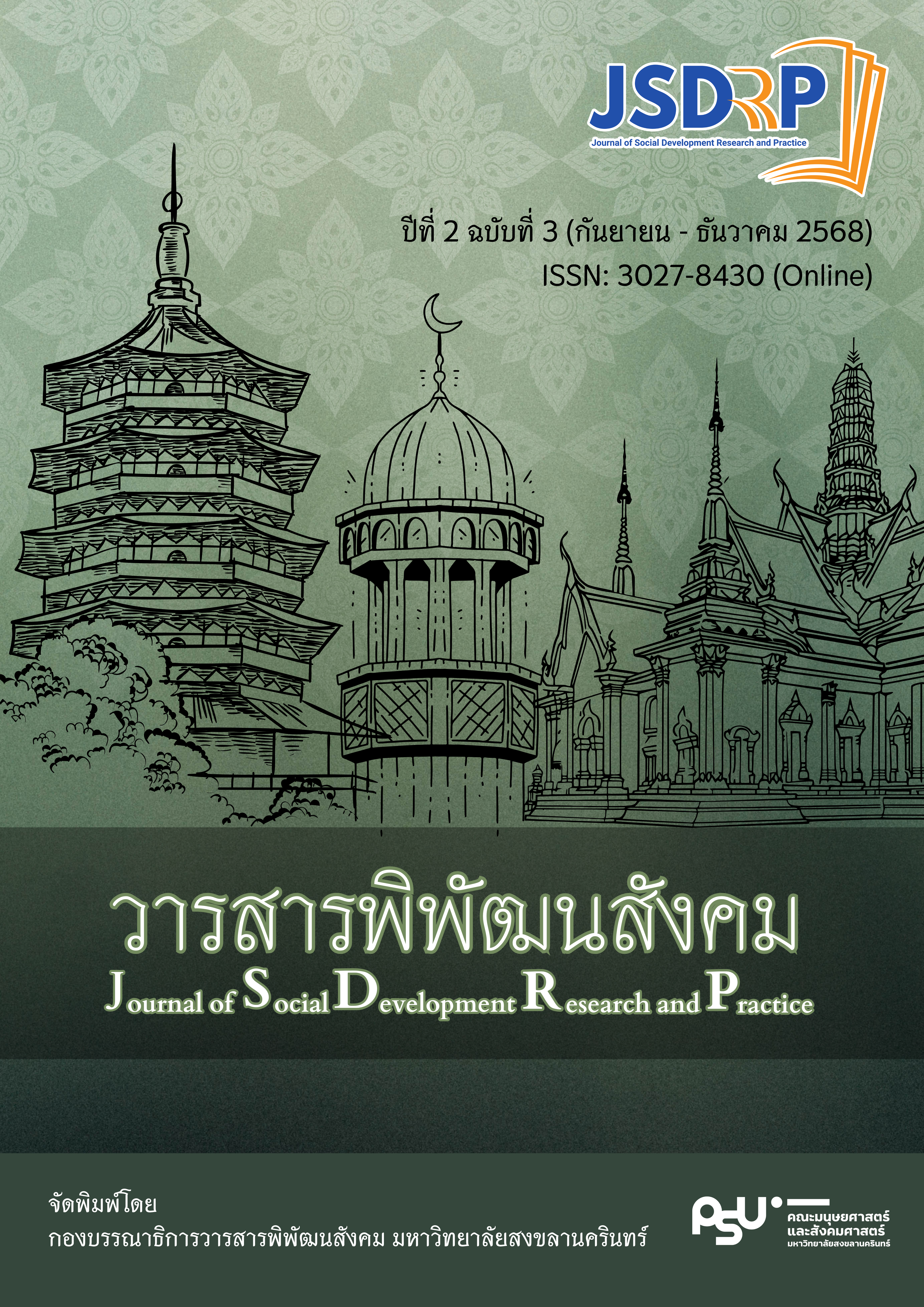An Evaluation of the “PROT JOB HUB” Project for Enhancing Career Skills and Promoting Income Generation among Students at Protpittayapayat School
Keywords:
CIPP model, Project evaluation, Career skills, Project management, Secondary schoolAbstract
Purpose: This study aimed to evaluate the “PROT JOB HUB” project in developing vocational skills and promoting income generation among students at Prot Phitthayaphayat School.
Methodology: The target group consisted of 184 participants, including students, teachers, parents, and entrepreneurs involved in the project during the second semester of the 2024 academic year. A purposive sampling technique was employed to select respondents relevant to the research objectives. The study applied Stufflebeam’s CIPP Model as the evaluation framework. Research instruments included a five-point Likert scale questionnaire and an interview form. Data were analyzed using mean, standard deviation, and content analysis.
Findings: The findings revealed that the overall implementation of the project was rated at a high level. The process dimension received the highest score, reflecting systematic participation and operations. The context and input dimensions were also evaluated highly. Although the output dimension met the expected goals, weaknesses remained in ensuring students’ sustainable income generation.
Applications of this study: The results can be applied to educational management, student affairs administration, and curriculum development in secondary schools. Moreover, the study provides practical implications for policymakers, educational administrators, and researchers in vocational training, project evaluation, and sustainable development to prepare students for careers and life skills in the 21st century.
References
กีรติ พรหมนรา, ชูศักดิ์ เอกเพชร และนัฎจรี เจริญสุข. (2564). การประเมินโครงการด้านการจัดการทักษะอาชีพและทักษะชีวิตในศตวรรษที่ 21 ของโรงเรียนบ้านฉลอง สังกัดสำนักงานเขตพื้นที่การศึกษาประถมศึกษาจังหวัดภูเก็ต. วารสารรัชต์ภาคย์, 15(41), 172–185.
กุลวดี แก้วประวัติ, อัคพงศ์ สุขมาตย์ และบุญจันทร์ สีสันต์. (2568). การประเมินโครงการเปิดโลกกว้างสร้างเส้นทางสู่อาชีพ ในโรงเรียนระดับมัธยมศึกษา สังกัดกรุงเทพมหานคร. วารสารศึกษาศาสตร์ มหาวิทยาลัยมหาสารคาม, 19(1), 68–86.
มูลนิธิสานอนาคตการศึกษา คอนเน็กซ์อีดี. (2564). กสศ.สำรวจสถานการณ์เด็กหลุดออกนอกระบบหลังเปิดเทอมใหม่. สืบค้นเมื่อ 30 กรกฎาคม 2568, จาก https://www.eef.or.th/news-eef-explore-children-falling-out-of-system-after-new-semester
สำนักงานคณะกรรมการการศึกษาขั้นพื้นฐาน. (2561). แนวทางการเสริมทักษะและสร้างเสริมประสบการณ์อาชีพให้กับนักเรียน. กลุ่มพัฒนาระบบการแนะแนวสำนักงานวิชาการและมาตรฐานการศึกษา. สืบค้นเมื่อ 30 กรกฎาคม 2568, จาก https://psdg.moe.go.th/wp-content/uploads/2023/06/2.-แนวทางการเสริมสร้างทักษะ.pdf
สำนักงานคณะกรรมการการศึกษาขั้นพื้นฐาน. (2567). ระบบจัดเก็บข้อมูลนักเรียนรายบุคคล (DMC). สืบค้นเมื่อ 30 กรกฎาคม 2568, จาก https://portal.bopp-obec.info/obec67
สำนักงานเลขานุการของคณะกรรมการยุทธศาสตร์ชาติ. (2561). ยุทธศาสตร์ชาติ พ.ศ. 2561-2580 (ฉบับย่อ). กรุงเทพฯ: สำนักงานคณะกรรมการพัฒนาการเศรษฐกิจและสังคมแห่งชาติ.
สุชาวดี สุดเอียด, รัฐพร กลิ่นมาลี และวีระยุทธ์ ชาตะกาญจน์. (2567). การประเมินโครงการท้องถิ่นภูมิปัญญา
พัฒนาทักษะอาชีพ โรงเรียนบ้านกุมแป สำนักงานเขตพื้นที่การศึกษาประถมศึกษานครศรีธรรมราช เขต 3. เสฏฐวิทย์ปริทัศน์, 4(3), 510–521.
สุพัตรา หนูทองอินทร์, ธณัฐชา รัตนพันธ์ และนพรัตน์ ชัยเรือง. (2567). การประเมินโครงการส่งเสริมทักษะอาชีพอิสระ สร้างรายได้ระหว่างเรียน ของนักเรียนชั้นมัธยมศึกษาตอนต้น โรงเรียนบ้านสันยูง สำนักงานเขตพื้นที่การศึกษาประถมศึกษานครศรีธรรมราช เขต 1. Journal of Buddhist Education and Research (JBER), 10(4), 185–199.
อุทัยวรรณ โพธิ์กระจ่าง. (2564). การประเมินผลสัมฤทธิ์โครงการการจัดการศึกษาตามพระราชดำริและการศึกษาอาชีพเพื่อการมีงานทำ ปีงบประมาณ 2562. Journal for Developing the Social and Community, 8(1), 33–46.
เยาวนาตร อินทร์สำเภา, พรทิพย์ อ้นเกษม, จิราภรณ์ พจนาอารีย์วงศ์, อังคณา กุลนภาดล และธนเทพ ศิริพัลลภ. (2566). การประเมินโครงการพัฒนาทักษะอาชีพและส่งเสริมการสร้างรายได้ ให้แก่เยาวชนในวัยเรียนของสถานศึกษาในตำบลดอนฉิมพลี อำเภอบางน้ำเปรี้ยว จังหวัดฉะเชิงเทรา. วารสารราชนครินทร์, 20(2), 105–120.
Best, J.W., & Kahn, J.V. (2006). Research in education. 10th edition. Boston: Pearson Education.
Fitzpatrick, J.L., Sanders, J.R., & Worthen, B.R. (2011). Program evaluation: Alternative approaches and practical guidelines. 4th ed. Boston, MA: Pearson.
Johnson, M., Smith, K., & Brown, L. (2022). Career readiness programs in Australian secondary schools: A comprehensive evaluation study. Journal of Career Development, 49(3), 567–583.
Lynch, P., & Moran, D. (2023). Systematic approaches to vocational skill development in US high schools: Lessons from successful programs. Educational Evaluation and Policy Analysis, 45(2), 298–317.
Madaus, G.F., Scriven, M.S., & Stufflebeam, D.L. (1986). Evaluation models: Viewpoints on educational and human services evaluation. Boston, MA: Kluwer-Nijhoff.
Patton, M.Q. (2008). Utilization-focused evaluation. 4th edition. Thousand Oaks, CA: Sage.
Scriven, M. (1972). The methodology of evaluation. In R.E. Stake (Ed.), Curriculum evaluation. AERA Monograph Series.
Stake, R.E. (1975). Evaluating the arts in education: A responsive approach. Columbus, OH: Merrill.
Stufflebeam, D.L. (1971). Educational evaluation and decision-making. Itasca, IL: Peacock.
Stufflebeam, D.L. (2003). The CIPP model for evaluation. In T. Kellaghan & D.L. Stufflebeam (Eds.), International handbook of educational evaluation. Dordrecht: Kluwer Academic.
Stufflebeam, D.L., & Shinkfield, A.J. (2007). Evaluation theory, models, and applications. San Francisco, CA: Jossey-Bass.
Tyler, R.W. (1949). Basic principles of curriculum and instruction. Chicago: University of Chicago Press.
Worthen, B.R., & Sanders, J.R. (1987). Educational evaluation: Alternative approaches and practical guidelines. New York: Longman.
Downloads
Published
How to Cite
Issue
Section
License
Copyright (c) 2025 Journal of Social Development Research and Practice

This work is licensed under a Creative Commons Attribution-NonCommercial-NoDerivatives 4.0 International License.
This work is licensed under a Creative Commons Attribution-NonCommercial-NoDerivatives 4.0 International License.





